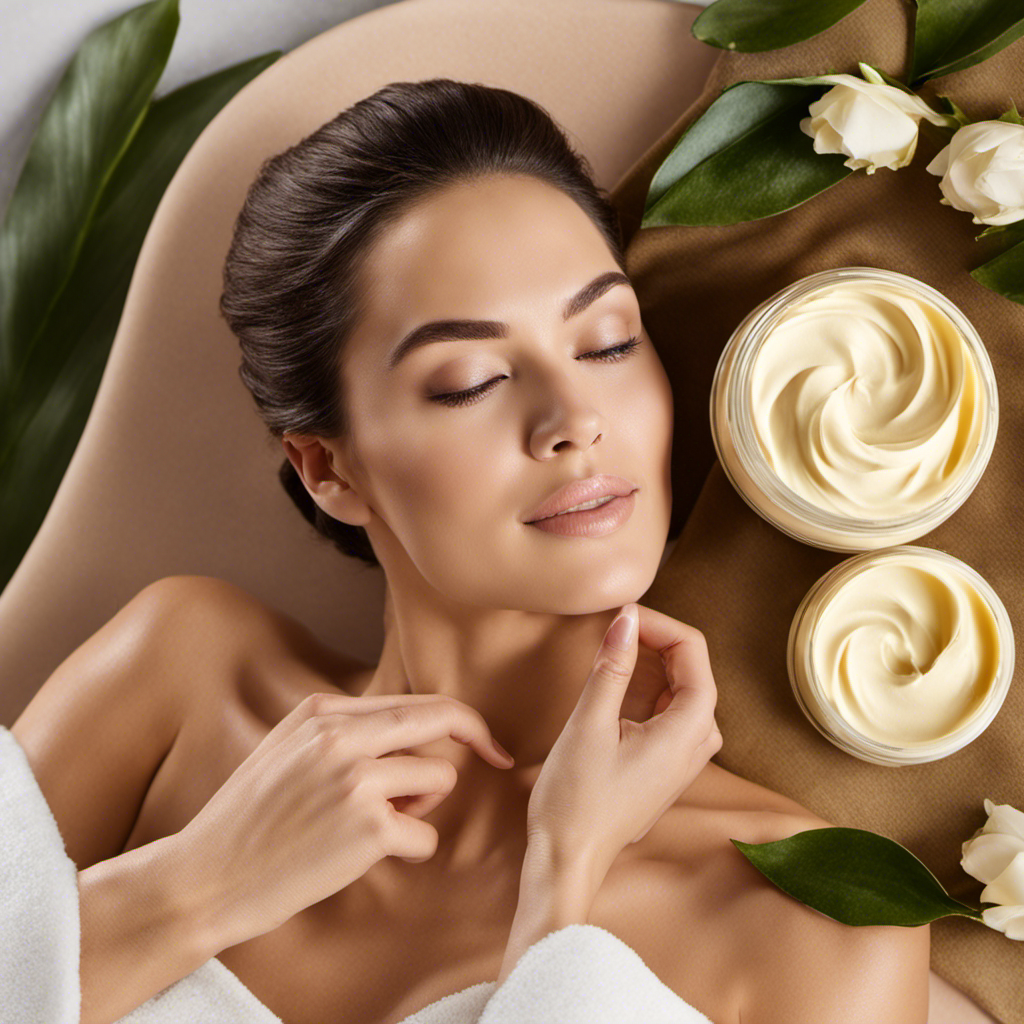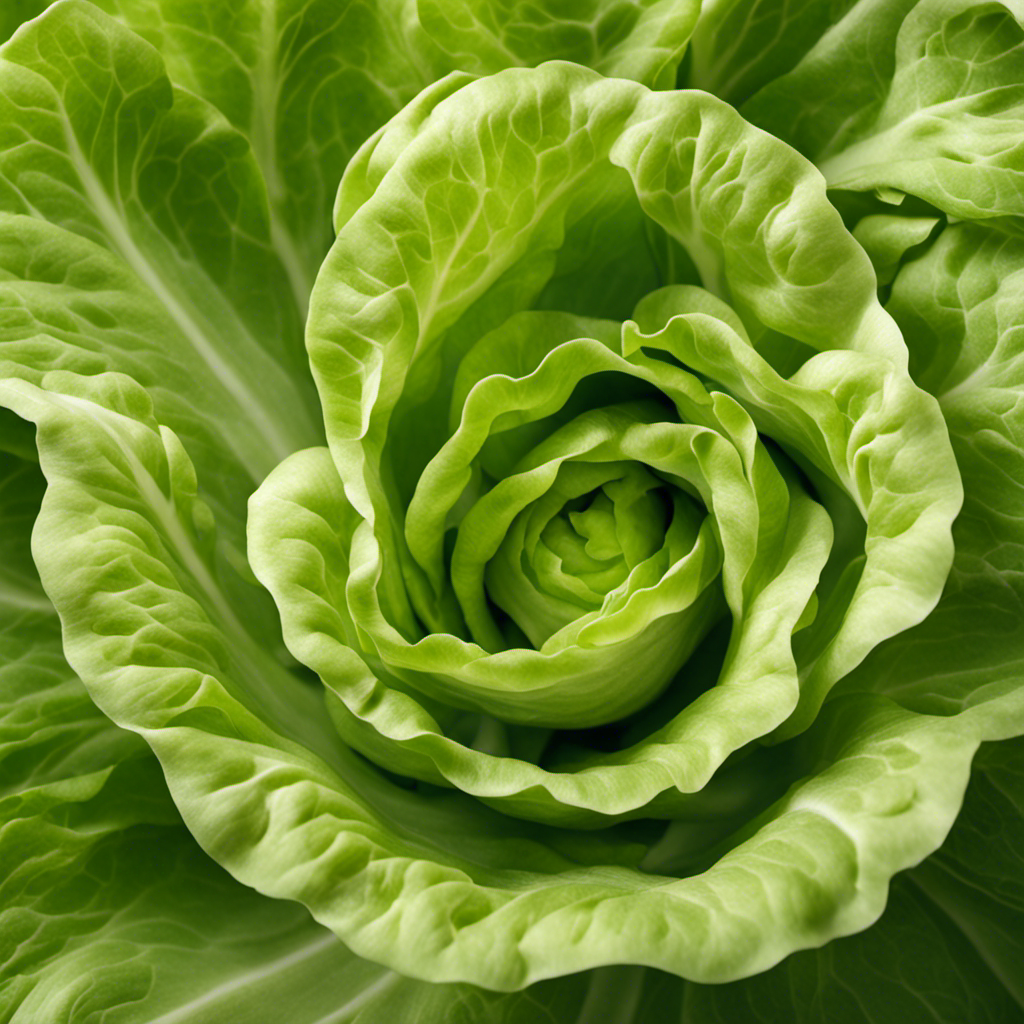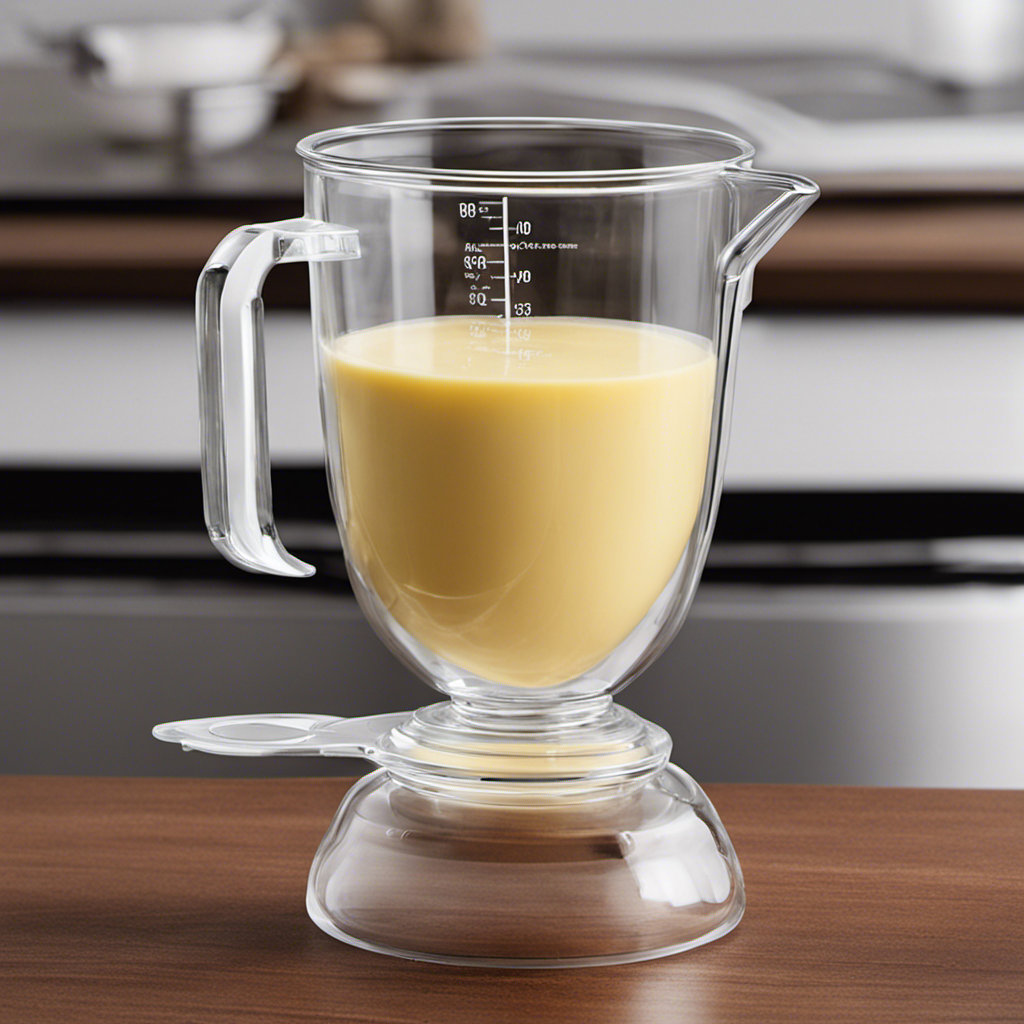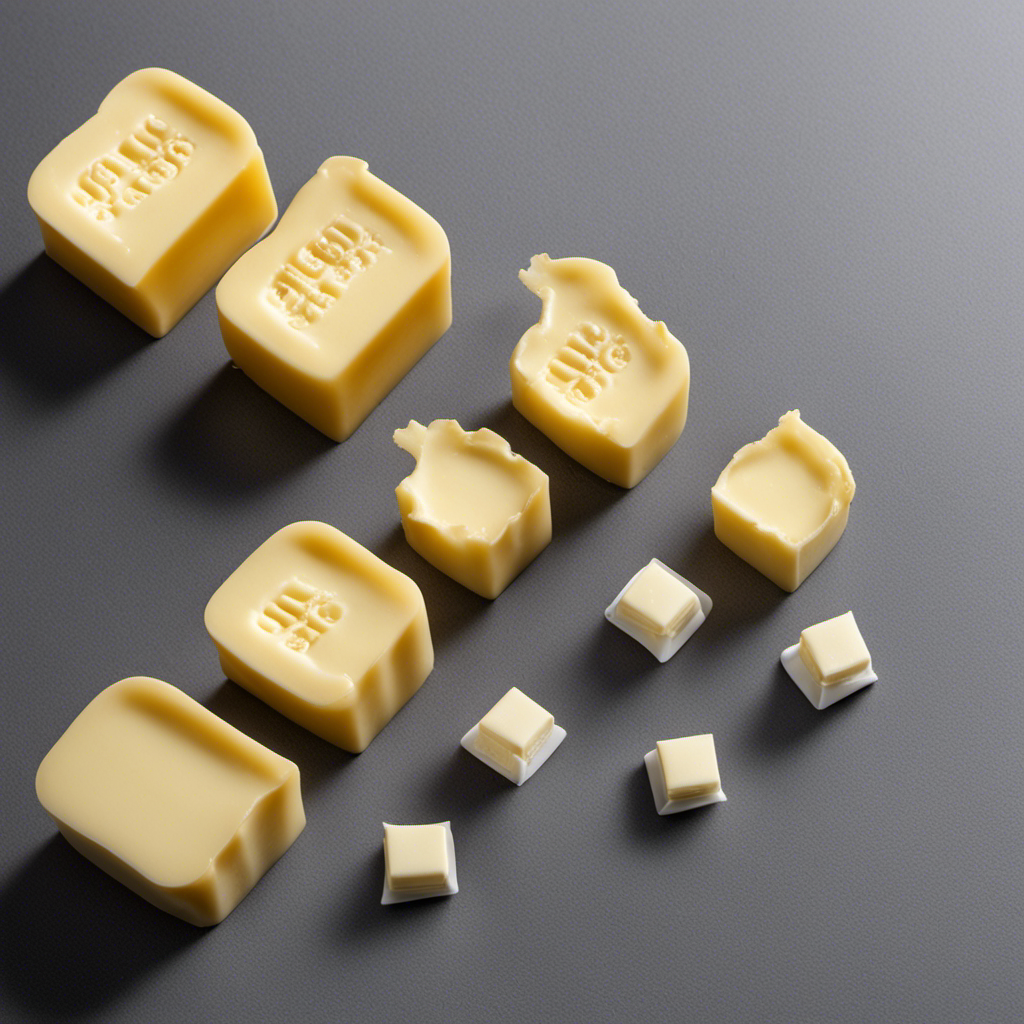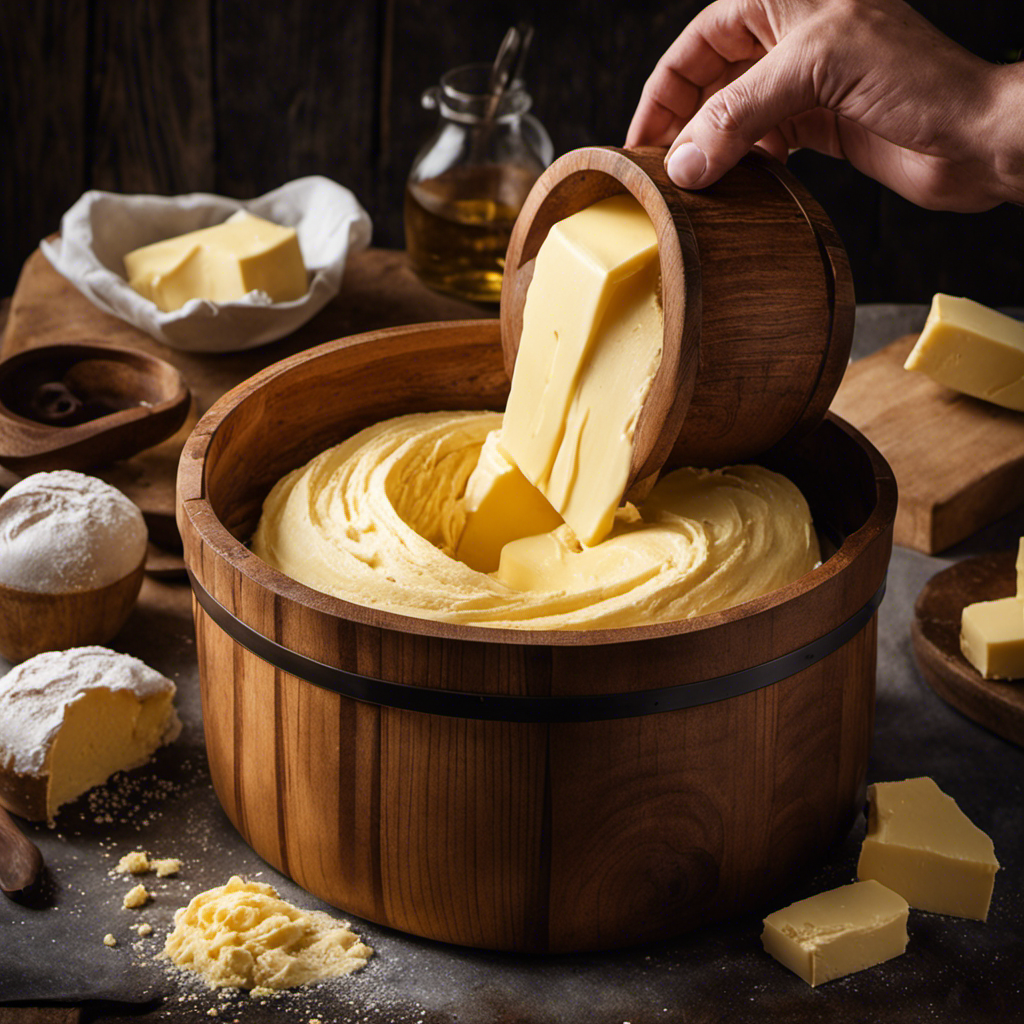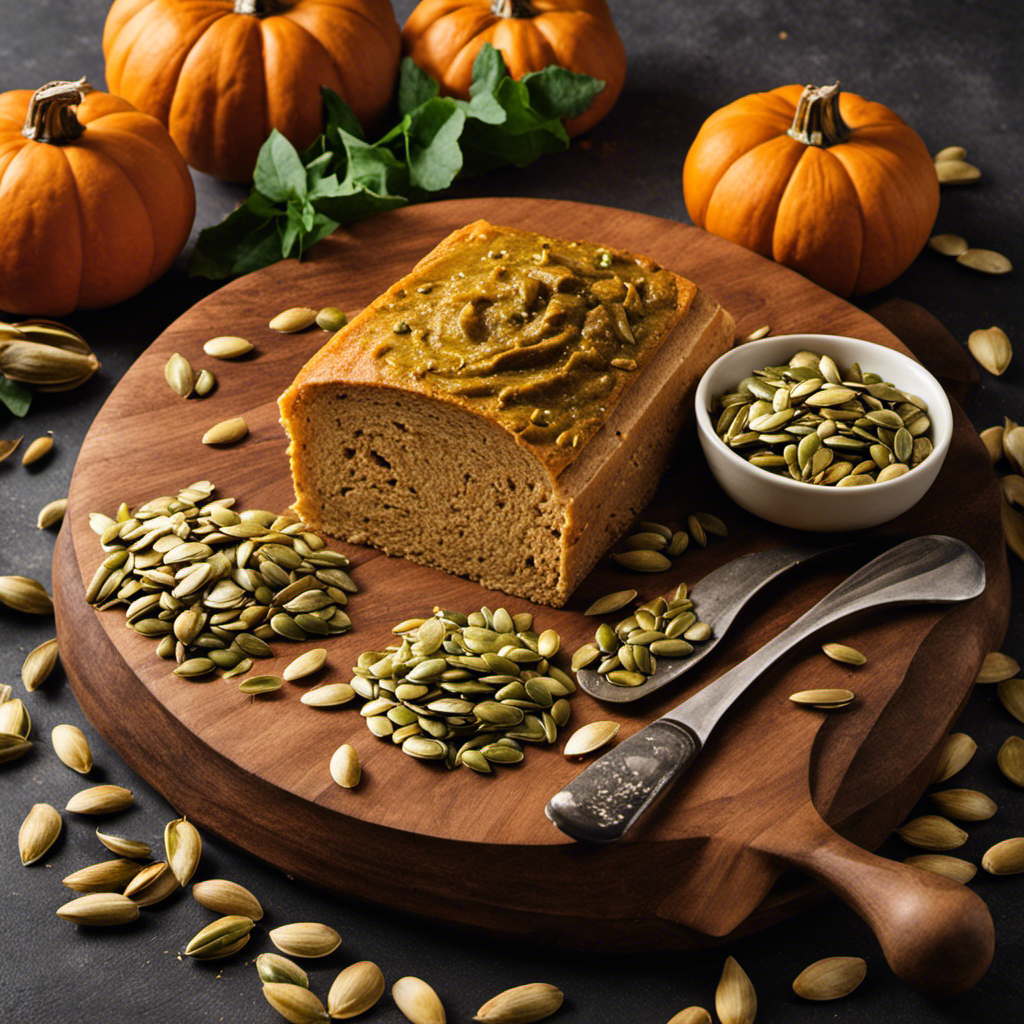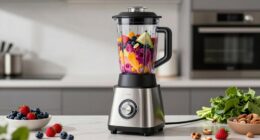As I run my fingers over my skin, I am reminded of the indulgent feeling of body butter. It’s like cocooning yourself in a plush, velvety fabric that helps to nourish and rejuvenate your skin.
But what do you use body butter for? Well, let me enlighten you. Body butter is a powerhouse moisturizer, hydrating and soothing even the driest and roughest skin.
It enhances elasticity, protects and repairs, and even has anti-aging properties. Get ready to indulge in the wonders of body butter and transform your skincare routine.
Key Takeaways
- Body butter deeply hydrates and moisturizes the skin, forming a protective barrier to prevent dryness.
- It enhances skin elasticity and provides anti-aging properties.
- Body butter is made from natural ingredients like shea butter and cocoa butter, and it improves texture and elasticity while reducing the appearance of fine lines and wrinkles.
- It also has soothing and calming benefits, promotes relaxation, and leaves the skin feeling rejuvenated and radiant.
Benefits of Using Body Butter
Using body butter can provide numerous benefits for your skin. Body butter is a rich and creamy moisturizer that is packed with nourishing ingredients. One of the main benefits of using body butter is its ability to deeply hydrate and moisturize the skin. The thick consistency of body butter allows it to form a protective barrier on the skin, locking in moisture and preventing dryness.
To apply body butter correctly, start by taking a small amount and warming it between your hands. Then, gently massage it onto your skin, focusing on dry areas. The warmth from your hands will help the body butter melt and absorb into your skin more easily. This ensures that you get the maximum benefits from using body butter.
Now, let’s explore the hydrating and moisturizing properties of body butter in more detail.
Hydrating and Moisturizing Properties of Body Butter
With its hydrating and moisturizing properties, body butter is perfect for nourishing dry skin. Body butter is a thick, creamy product that is made from natural ingredients such as shea butter, cocoa butter, and oils. It is designed to deeply hydrate and moisturize the skin, leaving it soft, smooth, and supple.
The benefits of body butter go beyond just hydration. It can also help to improve the texture and elasticity of the skin, reduce the appearance of fine lines and wrinkles, and protect against environmental damage. To use body butter, simply take a small amount and massage it into your skin, focusing on dry or rough areas. It can be used daily, preferably after showering or bathing, to lock in moisture and keep your skin looking and feeling healthy.
Transitioning into the next section, the nourishing and revitalizing effects of body butter can truly transform your skin.
Nourishing and Revitalizing Effects of Body Butter
The nourishing and revitalizing effects of body butter can truly transform your skin, leaving it feeling rejuvenated and looking radiant. This luxurious product is packed with essential nutrients that deeply nourish the skin, providing it with the moisture and hydration it craves.
Here are four ways body butter can benefit your skin:
-
Intense hydration: Body butter is formulated with rich, emollient ingredients like shea butter and cocoa butter that deeply penetrate the skin, providing long-lasting moisture and hydration.
-
Skin repair: The nourishing properties of body butter help to repair and restore damaged skin, improving its texture and elasticity.
-
Anti-aging effects: Body butter is often enriched with antioxidants that help to combat free radicals, reducing the signs of aging and promoting a youthful appearance.
-
Soothing and calming: The thick and creamy texture of body butter creates a soothing and calming effect on the skin, making it ideal for dry and sensitive skin types.
Experience the nourishing benefits and revitalizing effects of body butter for yourself, and unveil healthier, more radiant skin.
Soothing and Calming Benefits of Body Butter
Indulging in body butter can create a soothing and calming effect on your skin, leaving it feeling nourished and refreshed. Body butters are known for their soothing properties and relaxation benefits.
These luxurious creams are packed with rich moisturizing ingredients such as shea butter, cocoa butter, and essential oils. When applied to the skin, body butter forms a protective barrier that locks in moisture and helps to soothe dry, irritated skin.
The creamy texture of body butter allows for easy application and absorption, leaving your skin feeling soft and supple. Not only does body butter provide hydration, but it also has a calming effect on the mind and body.
The pleasant scent of body butter can help to relax and unwind, promoting a sense of tranquility and well-being. So go ahead and indulge in the soothing and calming benefits of body butter for a truly pampering experience.
Enhancing Skin Elasticity With Body Butter
Applying body butter regularly can help improve the elasticity of your skin, leaving it looking and feeling more supple. Here are four ways in which body butter enhances skin firmness and promotes collagen production:
-
Deep Hydration: Body butter contains rich and nourishing ingredients that penetrate deep into the skin, providing intense hydration. This helps to plump up the skin and improve its elasticity.
-
Nutrient Boost: Body butter is packed with vitamins and antioxidants that support collagen production. These nutrients help to strengthen the skin’s structure and improve its firmness.
-
Massage Benefits: When you apply body butter, you can massage it into your skin in circular motions. This stimulates blood flow and lymphatic drainage, promoting collagen production and enhancing skin firmness.
-
Preventing Stretch Marks: By keeping the skin well-hydrated and elastic, body butter can help prevent the formation of stretch marks.
Protecting and Repairing Skin With Body Butter
Using body butter regularly can help protect and repair your skin by enhancing its firmness and promoting collagen production. Body butter is a rich and nourishing moisturizer that contains natural ingredients like shea butter, cocoa butter, and essential oils. These ingredients provide deep hydration, seal in moisture, and create a protective barrier on the skin’s surface. This barrier helps to prevent moisture loss and shields your skin from environmental stressors such as pollution and harsh weather conditions. Additionally, body butter contains antioxidants that can help repair damage caused by free radicals and promote skin cell regeneration. By incorporating body butter into your skincare routine, you can effectively protect and repair your skin, leaving it soft, smooth, and healthy.
| Benefit | Description | Emotion |
|---|---|---|
| Protection | Body butter creates a protective barrier on your skin, shielding it from environmental stressors | Safety |
| Repair | The antioxidants in body butter help repair skin damage and promote cell regeneration | Renewal |
| Hydration | The rich moisturizing properties of body butter provide deep hydration for your skin | Nourishment |
| Nourishment | Natural ingredients in body butter nourish your skin, leaving it soft, smooth, and healthy | Vitality |
Anti-Aging Properties of Body Butter
The antioxidants in body butter can help reduce the appearance of fine lines and wrinkles, giving your skin a more youthful look. Body butter is not just a luxurious moisturizer; it also provides anti-aging benefits due to its natural ingredients. Here are four reasons why body butter is great for anti-aging:
-
Hydration: Body butter deeply moisturizes the skin, keeping it hydrated and plump, which helps to diminish the appearance of wrinkles.
-
Nourishment: The natural ingredients in body butter, such as shea butter and cocoa butter, are rich in vitamins and fatty acids that nourish the skin, promoting a healthier and more youthful complexion.
-
Protection: Body butter forms a protective barrier on the skin, shielding it from environmental damage and preventing premature aging caused by free radicals.
-
Regeneration: The powerful antioxidants in body butter help to stimulate collagen production, which can improve skin elasticity and reduce the signs of aging.
With its anti-aging benefits and natural ingredients, body butter is a must-have in any skincare routine.
Using Body Butter for Dry and Rough Skin
After discussing the anti-aging properties of body butter, let’s now explore its benefits for dry and rough skin.
Body butter is an excellent option for those with sensitive skin or conditions like eczema. The rich and nourishing formula of body butter helps to deeply moisturize and soothe dry, irritated skin. It forms a protective barrier on the skin’s surface, preventing moisture loss and promoting healing.
The natural ingredients in body butter, such as shea butter and cocoa butter, are known for their hydrating and emollient properties, making them ideal for providing relief to dry and rough skin. Whether you have dry patches or flaky areas, incorporating body butter into your skincare routine can help restore your skin’s softness and suppleness.
Incorporating Body Butter Into Your Skincare Routine
When it comes to incorporating body butter into your skincare routine, there are several key points to consider.
First, understanding the benefits of body butter is essential. It deeply moisturizes and nourishes the skin, leaving it soft, smooth, and hydrated.
Second, knowing the best application techniques can help maximize the effectiveness of your body butter. Applying it to slightly damp skin and massaging it in circular motions allows for better absorption and ensures all areas are covered.
Lastly, choosing the right formula is crucial. Opting for a body butter that suits your skin type and preferences, whether it’s a lightweight lotion or a rich and creamy texture, will enhance your overall skincare experience.
Benefits of Body Butter
One of the benefits of body butter is that it deeply moisturizes the skin. As someone with sensitive skin, I have found that using body butter specifically formulated for sensitive skin has been a game-changer.
Here are four reasons why body butter is a must-have for winter skincare:
-
Intense hydration: Body butter contains nourishing ingredients like shea butter and cocoa butter that deeply penetrate the skin, providing long-lasting moisture.
-
Protection against dryness: Winter weather can be harsh on the skin, leading to dryness and flakiness. Body butter forms a protective barrier, preventing moisture loss and keeping the skin hydrated.
-
Soothing properties: Body butter for sensitive skin often includes calming ingredients like aloe vera or chamomile, which help soothe irritation and redness.
-
Luxurious texture: The creamy texture of body butter feels indulgent on the skin, making it a pleasure to use during your winter skincare routine.
With these benefits, body butter is a must-have for anyone looking to keep their skin hydrated and healthy during the winter months.
Best Application Techniques
Now that we know the amazing benefits of body butter, it’s important to learn the best application techniques to make the most out of this luxurious product.
When it comes to applying body butter, there are a few key steps to follow for optimal results.
First, it’s essential to start with clean, dry skin. This ensures that the body butter can penetrate deeply and provide maximum hydration.
Next, take a small amount of body butter and warm it up between your hands. This helps to soften the product and allows for easier application.
Using gentle, upward strokes, massage the body butter onto your skin. Pay extra attention to dry areas such as elbows, knees, and feet. The rich and creamy texture of body butter will melt into your skin, leaving it feeling smooth and nourished.
One common mistake to avoid is using too much product. A little goes a long way with body butter, so start with a small amount and add more if needed.
Another mistake is applying body butter to damp skin, as this can prevent proper absorption.
Choosing the Right Formula
To ensure optimal results, it’s important to choose the right formula for your skin type and preferences. When it comes to body butter, there are a few things to consider:
-
Skin Type: Consider whether your skin is dry, oily, or combination. Look for body butters that are specifically formulated for your skin type to provide the best hydration and nourishment.
-
Fragrance: Choose a body butter with a fragrance that you love. Whether you prefer floral, fruity, or musky scents, there are plenty of options available to suit your preferences.
-
Ingredients: Look for body butters that contain natural, nourishing ingredients like shea butter, cocoa butter, or coconut oil. These ingredients will help to moisturize and soften your skin.
-
Application: When applying body butter, make sure to massage it into your skin in circular motions. This will help the product to absorb better and provide maximum hydration.
Frequently Asked Questions
Can Body Butter Be Used on the Face?
Using body butter on the face has pros and cons. It can provide intense hydration but may be too heavy for some skin types. Best practices include applying a thin layer and avoiding the eye area. Alternatives for facial skincare include lightweight moisturizers and serums.
Is Body Butter Suitable for All Skin Types?
Body butter is suitable for all skin types. I use it on my sensitive skin to nourish and hydrate, while others with dry skin benefit from its moisturizing properties. It’s a must-have for a healthy, glowing complexion.
How Often Should Body Butter Be Applied?
I apply body butter regularly to moisturize and nourish my skin. It helps to keep my skin hydrated and supple. There are different types of body butters available, each offering unique benefits for various skin concerns.
Can Body Butter Help With Stretch Marks?
Can body butter help with stretch marks? Yes, it can! I’ve found that using body butter regularly has been effective in fading my stretch marks. It’s a great option to consider for improving the appearance of these marks on your skin.
Can Body Butter Be Used as a Substitute for Sunscreen?
Body butter is a great moisturizer that can keep your skin hydrated and nourished. Regular use of body butter can provide numerous benefits, but it cannot be used as a substitute for sunscreen.
Conclusion
In conclusion, body butter is a versatile skincare product that offers numerous benefits. Its hydrating and moisturizing properties help to nourish and revitalize the skin, leaving it soft and supple.
Additionally, body butter soothes and calms the skin, making it perfect for relieving irritation or redness. It also enhances skin elasticity, protecting and repairing it from damage.
With its anti-aging properties, body butter can help to reduce and prevent the signs of aging. Whether you have dry and rough skin or simply want to incorporate it into your skincare routine, body butter is a must-have product.
As the saying goes, ‘Smooth as butter’, body butter will leave your skin feeling smooth and luxurious. So why not treat yourself to the indulgence of body butter and enjoy its incredible benefits?
